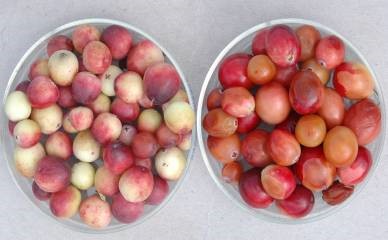New Jersey is well known for many things: Bruce Springsteen, boardwalks, diners. But it also known as a hot spot for cranberry fruit rot.

“Fruit rot is actually a series of diseases—Dr. Peter Oudemans calls it a disease complex—and there’s five major organisms that cause fruit rot,” Dr. Nicholi Vorsa, Co-PD and Professor at Rutgers University, said.
In New Jersey, it’s a very serious problem because the climate is much more conducive to fruit rot.
“I’ve always said that New Jersey offers the best place for breeding for fruit rot resistance. However, for the growers, it’s a problem,” Vorsa said. “Every year, if we don’t use fungicides, the New Jersey growers will experience basically 100% fruit rot. So, the crop, if not treated with fungicides, suffers great losses due to fruit rot.”
Vorsa has spent the past 40 years breeding for cranberry cultivars more resistant to the disease complex. According to Vorsa, growers will try to reduce heat stress by irrigating during the day to cool the plants when it gets above 93 degrees Fahrenheit. But that adds moisture to the canopy, increasing the incidence of fruit rot.
“A lot of the fruit rot issues are exacerbated by the heat stress that we experience in New Jersey pretty much every year”, Vorsa said.
According to Vorsa, it is critical for growers to start protecting their plants with fungicides early in the growing season.
“Research studies show that if plants are not sprayed with fungicides at about 10% into bloom that—regardless of whether you use spray afterwards or not—you experience high fruit rot,” Vorsa said. “So, the notion is that fruit rot infection occurs during bloom.”
Finding cultivars with natural resistance to fruit rot is an important step in battling the disease complex. Vorsa and his team are evaluating fruit rot in breeding plots. They’re also using a process called genotyping-by-sequencing (GBS) to find quantitative trait loci (QTLs) associated with the fruit rot resistance. Vorsa and his team have identified four cultivars with sources of resistance: ‘Budd’s Blues’, ‘US89-3’, ‘Holliston’, and ‘Cumberland’. However the crop yields of these varieties are not high.
“We hope to find different QTLs in these populations and validate them in subsequent breeding and selection series where we can hopefully use molecular technology to enhance and pyramid these genes into cultivars highly resistant to fruit rot with desirable crop yield.”
Vorsa’s team came across these genotypes in their cranberry germplasm collection in 2001 and 2002 when working to eliminate the need for fungicide sprays. Out of more than 600 plants, they found these four cultivars that seem to have some level of resistance. However, these were not the most productive of genotypes, and the team hopes to develop fruit rot resistant cultivars with commercially acceptable yields through breeding.
“Back 30 years ago, I started crossing resistant cultivars such as ‘Budd’s Blues’ with our most productive genotypes, such as ‘Stevens’, ‘Pilgrim’, and ‘Ben Lear’ that were generated from the first breeding cycle back in the 1920s for false blossom resistance,” Vorsa said. “Unfortunately, it seemed that the yields were very, very poor, so I discontinued that approach. After 2002, cultivars such as ‘Crimson Queen’, ‘Demoranville’, and ‘Mullica Queen’ came on board. So, we attempted again to cross the resistance into the higher yielding genotypes. It seemed that these cultivars would perform better overall for yield. So, I got encouraged from that standpoint.”
Something the team has discovered in crossing various genotypes has been the significance of the selection #35 parent. Vorsa notes that three cultivars in particular—’Mullica Queen’, ‘Vasanna’, and ‘Haines’—have selection #35 as a parent, which seems to increase yield in the progeny.
“Our successful cultivars right now have the selection #35 in the background,” Vorsa said. “Hopefully, we can amend the poor productivity of the resistant genotypes with the genetics of the better adaptive cultivars for yield. We have evidence that we should be able to select plants that have high yield and high fruit rot resistance.”
According to Vorsa, getting to this point in his research has taken quite a while—he started in 1985—and he feels fortunate to have found selection #35 through fingerprinting done on the early end. While these genotypes are promising, Vorsa does note that they don’t have anything that’s completely immune to fruit rot and thinks that a cultivar with yields like ‘Mullica Queen’ would be a long way off—if ever.
“I don’t think we’ll give up fungicides completely, but we can reduce the number of sprays and applications from five or six to one or two,” Vorsa said.
Understanding fruit rot and its connections to heat stress is even more important when factoring in rising yearly temperatures and how climate change could impact places where fruit rot isn’t currently as much of an issue.
“If you have a sustained breeding program, you’re basically breeding for the climate that exists today,” Vorsa said. “I think the cultivars we selected here in New Jersey are doing fairly well. The last two decades, the temperatures have been higher. So, we’re essentially selecting for adaptation for the current conditions.”
As the climate gets warmer, Vorsa anticipates cultivars from New Jersey will even do better in Wisconsin.
“These genotypes require heat for fruit size,” Vorsa said. “And New Jersey typically has the largest fruit of any growing area, followed by Wisconsin and then the West Coast. The temperatures that they are exposed to basically have an impact on yield, and if you have a berry size that increases by 10%, that’s basically increasing yield by 10%.”
Vorsa is hopeful their next generation breeding cycle and selection plants have cultivars that are more adapted to the warmer climate, while also having the yield and fruit rot resistance they’re looking for. How long will growers have to wait for these new cultivars? Vorsa says it depends.
“We have a population that was replicated four times—it was a cross done in 2014. We have over 220 individuals, and I’m working with Juan Zalapa (USDA-ARS) and Massimo Iorizzo (University of North Carolina) on this to use as a mapping population,” Vorsa said. “We are finding some progeny with, higher level of resistance and improved yields .”













